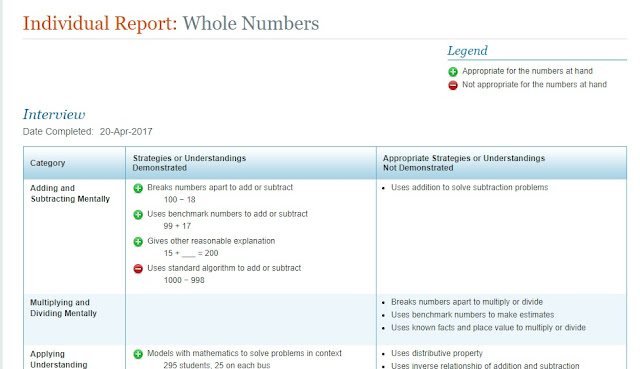This year I will be starting the year with the assessments right away, and I think you should too!
This post contains affiliate links. I earn a small commission each time someone makes a purchase using one of my links, which helps to support the blog. All opinions are my own and I only promote brands and products that I have used myself and truly love.
What is the Math Reasoning Inventory?
The Math Reasoning Inventory is a free on-line assessment tool that helps you learn about your students' numerical reasoning. It was developed by math expert Marilyn Burns. The site says that it is appropriate for grades 5 and up, but I have used it with my 4th graders, and I think you could successfully use the whole numbers inventory in 3rd grade.
Unfortunately, the inventory was removed from the website. But, if you email me, I will send you a pdf version.
If you teach a lower grade, I would still give it a look, because I think you could implement a similar process that would be so powerful for understanding what your students are thinking in math.
There are three assessments: whole numbers, fractions, and decimals. Each section contains a 4 question written test and an individual face to face interview where students are asked to explain how they came up with the answer.
I printed each of these from the website on card stock and laminated them for durability. I used colored card stock to print out the covers so I can find them easily. I placed the cards on a binder ring for storage and ease of use.
I have the students take the written assessment as a whole group assignment. I break down the interview process similarly to reading assessments with about 4 students per day.
Most of the questions are asked as mental math problems, but one or two have the students use pen and pencil (or in my case dry erase markers) to solve.
The program has a section to keep track of what types of errors students make and a place to make notes about what you observe.
Once you have assessed your students, reports are generated for both individuals and whole group.
Aside from the data provided from the computer, I was able to observe things about my students' thinking that I might not have otherwise observed.
I saw some great results this Spring after using for just a few short months, I can't wait to see the results next Spring after using the assessments (and lessons developed from the results) from the beginning of the year.
If you decide to try out the math inventory, I would love to hear how it goes! Leave a comment below or tag me on Twitter or Instagram!
And while you're here, enter to win one of our fabulous giveaways!
I will also be sharing some other assessments I use in my classroom in the next few weeks, so make sure to check them out!
If you like this post and don't want to miss out on future posts, please subscribe to my newsletter.
If you teach a lower grade, I would still give it a look, because I think you could implement a similar process that would be so powerful for understanding what your students are thinking in math.
There are three assessments: whole numbers, fractions, and decimals. Each section contains a 4 question written test and an individual face to face interview where students are asked to explain how they came up with the answer.
I printed each of these from the website on card stock and laminated them for durability. I used colored card stock to print out the covers so I can find them easily. I placed the cards on a binder ring for storage and ease of use.
I have the students take the written assessment as a whole group assignment. I break down the interview process similarly to reading assessments with about 4 students per day.
Most of the questions are asked as mental math problems, but one or two have the students use pen and pencil (or in my case dry erase markers) to solve.
The program has a section to keep track of what types of errors students make and a place to make notes about what you observe.
Once you have assessed your students, reports are generated for both individuals and whole group.
Aside from the data provided from the computer, I was able to observe things about my students' thinking that I might not have otherwise observed.
I saw some great results this Spring after using for just a few short months, I can't wait to see the results next Spring after using the assessments (and lessons developed from the results) from the beginning of the year.
If you decide to try out the math inventory, I would love to hear how it goes! Leave a comment below or tag me on Twitter or Instagram!
And while you're here, enter to win one of our fabulous giveaways!
I will also be sharing some other assessments I use in my classroom in the next few weeks, so make sure to check them out!
If you like this post and don't want to miss out on future posts, please subscribe to my newsletter.



























